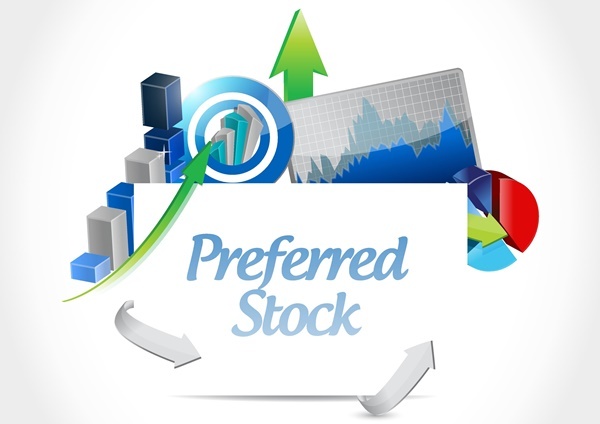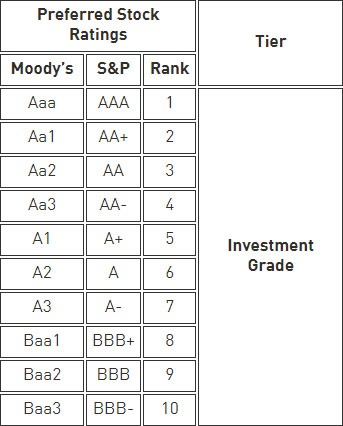In our previous article, Have You Considered Preferred Stocks, we discussed U.S. preferred stocks as an investment idea. As a conservative income-generating instrument, preferred stocks have a lot to offer. Their reason for being is to pay dividends. Dividend yields for investment-grade preferred stocks are now in the mid 6 to over 8%, and sometimes even higher. On lower-rated preferreds, yields are higher still. Preferred stock prices are much less volatile than common stock prices, though they do fluctuate more than bond prices. And some preferred shares have preferential tax treatment.
The preferred stock world is pretty diverse – at last count, almost 500 different preferred stocks were available, issued by all kinds of companies. The biggest issuers of preferred stock are banks; REITs and utilities are also big users. There are quite a few web sites that are dedicated to preferred stocks, so research is not hard to do.
For individual investors interested in preferred stocks, a few selection criteria can help you narrow down the list of candidates:
1. Credit rating.
Many issuers of preferred shares have credit ratings assigned by the same rating agencies that rate bonds – Moody’s and Standard and Poor’s. A Standard & Poor’s ratings of BBB- or better, or a Moody’s rating of Baa3 or higher are considered Investment Grade, meaning there is a low risk of default. Below are the rating scales:
Interestingly, not all preferred stock issuers have their shares rated. Less than half have any ratings at all. Banks, which are the largest issuers of preferred stock, almost never submit their preferred shares for ratings. Not having a credit rating doesn’t necessarily mean that the preferred stock is a bad risk – but it does mean that you have no way of knowing. If you are concerned about the safety of your investment, sticking to preferred shares rated investment grade is a good place to start.
2. Cumulative Dividends
Some preferred stock shares are cumulative – meaning that if the issuer misses a dividend because of insufficient cash flow, they must make it up later. However, not all issues are cumulative – only about two out of three. During the 2008 financial crisis, many banks suspended their dividends for many months and were not required to make them up.
Taken together, narrowing down the entire preferred stock universe to those issues that are both investment grade and cumulative cuts down the population to under 180 issues – a manageable number to evaluate.
3. Liquidity
Liquidity of the preferred shares can be an issue. Because preferred shares are more thinly traded than common shares, the spread between the Bid and Ask prices can be large. For individual investors, who generally buy at the Ask price and eventually sell at the Bid price, the bid-ask spread is a cost of owning the shares. Even though you may have no intention of selling the preferred shares you buy today any time soon, you will eventually incur the spread. It is not uncommon for the spread to exceed a year’s worth of dividend income. A precious few preferred issues have bid-ask spreads of less than two quarters’ worth of dividends. It is easy to observe the bid-ask spread of any preferred issue you are thinking of buying within your online trading platform.
4. Qualified or non-qualified dividends
For investors who plan to hold preferred shares in a taxable (non-IRA) account, the qualified nature of many preferred stock dividends is important. For those preferreds whose dividends are qualified (which are most preferreds issued by companies other than REITS), the dividends are taxed at the investor’s long-term capital gains tax rate, rather than their ordinary income tax rate as bond interest income would be.
Filtering preferred stock shares by all of these criteria: credit ratings. cumulative vs non-cumulative, liquidity and qualification of the dividends, will narrow down your search to a handful of candidates. Choose them well, and preferred shares can reward you with years of stable income at high rates.
Read the original article here - Preferred Stocks – How to Choose?
This content is intended to provide educational information only. This information should not be construed as individual or customized legal, tax, financial or investment services. As each individual's situation is unique, a qualified professional should be consulted before making legal, tax, financial and investment decisions. The educational information provided in this article does not comprise any course or a part of any course that may be used as an educational credit for any certification purpose and will not prepare any User to be accredited for any licenses in any industry and will not prepare any User to get a job. Reproduced by permission from OTAcademy.com click here for Terms of Use: https://www.otacademy.com/about/terms
Editors’ Picks

EUR/USD gains traction toward 1.0850 after Eurozone data
EUR/USD picks up fresh bids and rises to near 1.0850 in the European session on Monday. The pair draws support from upbeat Eurozonr Sentix Investor Confidence data for March, which came in at -2.9 from February's -12.7, lifting the sentiment around the Euro.

GBP/USD holds losses near 1.2900 amid risk-off mood
GBP/USD has come under renewed selling pressure and trades near 1.2900 in European trading on Monday. The pair is undermined by US tariffs uncertainty-led risk aversion and a pause in the US Dollar downtrend. All eyes remain on Trump's tariff updates amid a data-quiet calendar.

Gold steadies as traders look for direction on Trump tariffs
Gold’s price stabilizes and consolidates within a tight range near the $2,900 level at the start of the week. Traders are mulling over comments from United States President Donald Trump after an interview on Fox News over the weekend. Trump said that the economy is in a ‘transition’ phase.

Crypto market lost $440 million in market cap despite regulation and BTC reserve clarity
The overall crypto market capitalization lost over $440 million last week; on Monday, it reads $2.66 trillion. The reaction to Trump’s announcement of the Strategic Bitcoin Reserve wasn’t what many expected.

February CPI preview: The tariff winds start to blow
Consumer price inflation came out of the gate strong in 2025, but price growth looks to have cooled somewhat in February. We estimate headline CPI rose 0.25% and the core index advanced 0.27%. The moderation in the core index is likely to reflect some giveback in a handful of categories that soared in January.
RECOMMENDED LESSONS
Making money in forex is easy if you know how the bankers trade!
Discover how to make money in forex is easy if you know how the bankers trade!
5 Forex News Events You Need To Know
In the fast moving world of currency markets, it is extremely important for new traders to know the list of important forex news...
Top 10 Chart Patterns Every Trader Should Know
Chart patterns are one of the most effective trading tools for a trader. They are pure price-action, and form on the basis of underlying buying and...
7 Ways to Avoid Forex Scams
The forex industry is recently seeing more and more scams. Here are 7 ways to avoid losing your money in such scams: Forex scams are becoming frequent. Michael Greenberg reports on luxurious expenses, including a submarine bought from the money taken from forex traders. Here’s another report of a forex fraud. So, how can we avoid falling in such forex scams?
What Are the 10 Fatal Mistakes Traders Make
Trading is exciting. Trading is hard. Trading is extremely hard. Some say that it takes more than 10,000 hours to master. Others believe that trading is the way to quick riches. They might be both wrong. What is important to know that no matter how experienced you are, mistakes will be part of the trading process.

The Best brokers to trade EUR/USD
SPONSORED Discover the top brokers for trading EUR/USD in 2025. Our list features brokers with competitive spreads, fast execution, and powerful platforms. Whether you're a beginner or an expert, find the right partner to navigate the dynamic Forex market.



